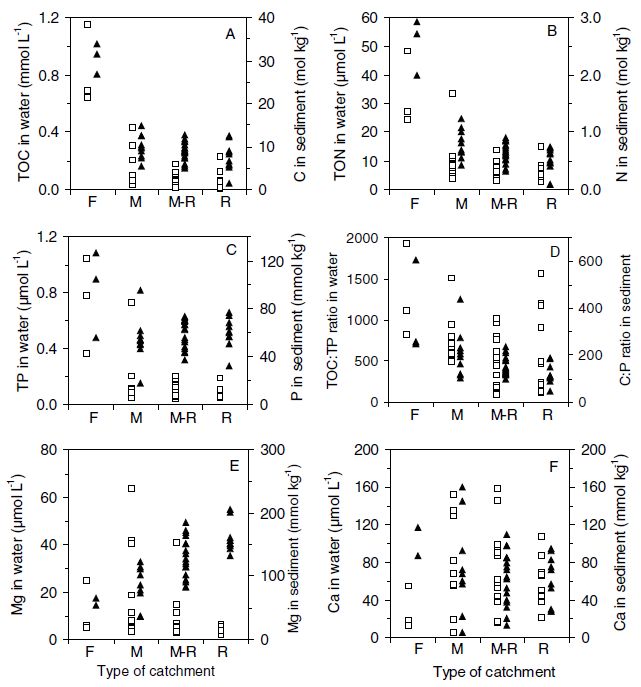 Concentrations of major nutrients (C, N, P) and acid soluble metals (Ca, Mg, K, Al, Fe, Mn, Pb, and Zn) were determined in modern (0–1 cm) and pre-acidification (5–10 cm) sediment layers collected from 37 alpine and 3 forest lakes in the Tatra Mountains (Slovakia, Poland) in 1996–1998. Sediment composition reflected catchment characteristics and productivity of lakes. In the sediments of alpine lakes, C and N concentrations decreased and Mg increased with a decreasing proportion of vegetation and soil in the catchment. Decreasing Ca:Mg ratios in sediments along the vegetation gradient was inverse to that in water, and could be associated with different ratios of cations in water leachate from catchments and in solids which enter the lake due to soil erosion. Phosphorus concentrations increased with the proportion of moraine areas, with till soils rich in P. Concentrations of C, N, P, and Ca in sediments positively correlated to their concentrations in water. Sediment concentrations of Al and Al:Ca ratios increased with decreasing sediment and water pH. A negative correlation between water pH and concentrations of organic C in water and sediments indicated the important impact of organic acids on the acid status of the lakes exposed to higher terrestrial export of organic matter. Compared to the pre-acidification period, the modern sediments had significantly higher Fe, Mn, Zn, Pb, and K, but lower Mg concentrations. The Zn and Pb enrichment was more evident in oligotrophic alpine lakes than in more productive forest lakes and was independent of lake water or sediment pH. Fe and Mn concentrations in the modern sediments were higher than in ambient soils and bedrock, while those in pre-acidification sediments were similar to contemporary soils and to the rock layer. The enrichment of the modern sediments with Fe and Mn thus probably resulted from both their redox recycling and ecosystem acidification.
Concentrations of major nutrients (C, N, P) and acid soluble metals (Ca, Mg, K, Al, Fe, Mn, Pb, and Zn) were determined in modern (0–1 cm) and pre-acidification (5–10 cm) sediment layers collected from 37 alpine and 3 forest lakes in the Tatra Mountains (Slovakia, Poland) in 1996–1998. Sediment composition reflected catchment characteristics and productivity of lakes. In the sediments of alpine lakes, C and N concentrations decreased and Mg increased with a decreasing proportion of vegetation and soil in the catchment. Decreasing Ca:Mg ratios in sediments along the vegetation gradient was inverse to that in water, and could be associated with different ratios of cations in water leachate from catchments and in solids which enter the lake due to soil erosion. Phosphorus concentrations increased with the proportion of moraine areas, with till soils rich in P. Concentrations of C, N, P, and Ca in sediments positively correlated to their concentrations in water. Sediment concentrations of Al and Al:Ca ratios increased with decreasing sediment and water pH. A negative correlation between water pH and concentrations of organic C in water and sediments indicated the important impact of organic acids on the acid status of the lakes exposed to higher terrestrial export of organic matter. Compared to the pre-acidification period, the modern sediments had significantly higher Fe, Mn, Zn, Pb, and K, but lower Mg concentrations. The Zn and Pb enrichment was more evident in oligotrophic alpine lakes than in more productive forest lakes and was independent of lake water or sediment pH. Fe and Mn concentrations in the modern sediments were higher than in ambient soils and bedrock, while those in pre-acidification sediments were similar to contemporary soils and to the rock layer. The enrichment of the modern sediments with Fe and Mn thus probably resulted from both their redox recycling and ecosystem acidification.
Keywords: acidification; lake; metals; nutrients; paleolimnology; Poland; Slovakia; water chemistry
